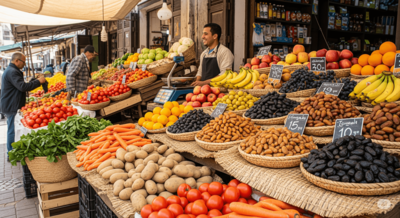TL;DR:
- Bahrain’s agricultural output rose 55% over the past decade, reaching 58,597.5 tonnes in 2024, with vegetable production nearly doubling to 28,600 tonnes.
- Greenhouse farming and controlled-environment agriculture are driving the shift toward greater food self-reliance and year-round production, compensating for limited arable land and harsh climate.
- Fruits, though previously marginal, have seen the fastest growth, while date production remains steady, underscoring both traditional crops and emerging trends in the sector.
Bahrain’s agricultural sector has undergone a significant transformation, as newly published data on Bahrain open data portal confirm a 55% increase in total farm output over the past ten years, with overall production climbing from 37,806.5 tonnes in 2015 to 58,597.5 tonnes in 2024. This rise is especially notable in the vegetable segment, which nearly doubled to 28,600 tonnes and now makes up the largest share of Bahrain’s domestic farm production. Farmers have prioritized staple vegetables and crops that align with local consumption, favouring those that support short supply chains and reduce dependence on imports.
Greenhouse and controlled-environment farming
A standout trend is the sharp shift toward greenhouse and covered farming. Production from crops grown under controlled conditions increased from 9,405 tonnes in 2015 to 15,900 tonnes in 2024. These methods address Bahrain’s climate and soil constraints, enabling more consistent, resource-efficient yields even during the region’s hottest months. Government-backed investments in hydroponics and greenhouse complexes have allowed growers to dramatically cut water usage and increase production cycles, especially for popular items like tomatoes, cucumbers, and leafy greensYear-round greenhouse agriculture is now seen as a core strategy for food security, with greenhouse-grown tomatoes holding a dominant share of output. Hydroponic farms have similarly scaled up, with some large operations targeting annual production in excess of 5,000 tonnes.
Fruits and Dates: Tradition meets change
Date production, a cornerstone of Bahraini agriculture, has remained steady, hovering from 13,200 tonnes in 2015 to 14,000 tonnes in 2024. Dates account for nearly half of all fruit output and are key for both domestic consumption and selective export opportunities, particularly within the GCC. Efforts are underway to further improve yields and quality with the help of salt-tolerant varieties and advanced orchard managementWhat’s striking is the explosive growth in fruit production outside dates, what used to be a negligible harvest (just 1.5 tonnes in 2015) surged to nearly 100 tonnes by 2024, following the introduction of controlled-environment orchards and improved agronomy practices. Pomegranates and other high-value, resilient crops are being championed by both the private sector and national food security programs.
Challenges and forward outlook
Despite this robust growth, Bahrain’s agricultural sector faces persistent challenges due to shrinking arable land (urbanization), climate change, and high input costs. Import reliance for key staples (such as wheat) continues, but the country’s rapidly expanding greenhouse and hydroponic capacity are expected to anchor its food self-reliance for select crops.Bahrain’s agriculture market size reached $634 million in 2025 and is forecast to continue growing, with vegetables and leafy greens leading at an anticipated CAGR of 4–7% over the remainder of the decade as per Mordor Intelligence.Bahrain’s farm sector reflects a successful pivot toward sustainable, high-value, and resource-efficient agriculture. Greenhouse and hydroponic farming are no longer exceptions but mainstream strategies, helping the kingdom double vegetable production and significantly improve domestic supply of fruits and other crops, all while aligning with ambitious government-led food security and economic diversification goals. Bahrain now stands as a regional case study in making agriculture thrive in a challenging environment, underpinned by clear official data and tangible progress.






